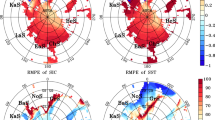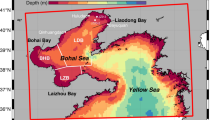Abstract
The HAMSOM (Hamburg Shelf Ocean Model), a high-resolution regional ice-ocean coupled model, was applied to investigate the seasonal evolution of Bohai Sea ice for winter 2015/2016. HAMSOM was initialized with monthly climatological temperature and salinity data from WOA13 and driven by hourly meteorological data obtained from the NCEP above the sea surface and tides at the open boundary. The ice model used here is a modified Hibler-type dynamic-thermodynamic sea ice model based upon viscous-plastic rheology. The ice extent, concentration, area, thickness, length of ice season as well as the distance between the top of Liaodong Bay (North China) and the outer ice edge line were simulated and compared with the observed data. Three types of modeling experiments were carried out to investigate the effects of wind, tide, and both wind and tide on Bohai Sea ice. The results show that wind, as both a dynamic and a thermodynamic factor, has a significant impact on the ice thickness, ice area, and ice-freezing and ice breakup dates as well as the ice velocity, while tides are a dynamic factor that influences only the ice velocity. During the severe ice period, the wind speed intensity increased by 25%, the average ice thickness thickened by approximately 4.0 cm in Liaodong Bay, approximately 2.1 cm in Bohai Bay and approximately 2.5 cm in Laizhou Bay, and the total ice coverage area and total ice actual area increased by about 2×104 km2 and 1.4×104 km2, respectively. While the tidal amplitude intensity increased by 25%, the average ice velocity increased by approximately 0.1 m/s.
Similar content being viewed by others
References
Backhaus J O. 1985. A three-dimensional model for the simulation of shelf sea dynamics. Deutsche Hydrografische Zeitschrift, 38(4): 165–187.
Backhaus J O, Harms I, Hübner U. 2008. Improved representation of topographic effects by a vertical adaptive grid in Vector-Ocean-Model (VOM). Part II: simulations in unstructured adaptive grids. Ocean Modelling, 22(3-4): 128–145.
Bai S, Wu H D. 1998. Numerical sea ice forecast for the Bohai Sea. Acta Meteorologica Sinica, 56(2): 139–153. (in Chinese with English abstract)
Blumberg A F, Mellor G L. 1987. A Description of a Three‐ Dimensional Coastal Ocean Circulation Model. In: Heaps N S ed. Three‐Dimensional Coastal Ocean Models. AGU, Washington.
Cai S Q, Wang W Z. 1999. Three-dimensional numerical simulation of South China Sea circulation in winter and summer. Acta Ocean olog ica Sinica, 21(2): 27–33. (in Chinese with English abstract)
Collins M, Minobe S, Barreiro M, Bordoni S, Kaspi Y, Kuwano-Yoshida A, Keenlyside N, Manzini E, O’Reilly, C H, Sutton R, Xie S P, Zolina O. 2018. Challenges and opportunities for improved understanding of regional climate dynamics. Nature Climate Change, 8(2): 101–108.
Connolley W M, Gregory J M, Hunke E, McLaren A J. 2004. On the consistent scaling of terms in the sea-ice dynamics equation. Journal of Physical Oceanography, 34(7): 1 776–1 780.
Dong B. 2012. Pollution status of the Bohai Sea and control countermeasures. Ecological Science, 31(5): 596–600. (in Chinese with English abstract)
Hibler III W D. 1979. A dynamic thermodynamic sea ice model. Journal of Physical Oceanography, 9(4): 815–846.
Huang D J, Su J L, Zhang L R. 1998. Numerical study of the winter and summer circulation in the Bohai Sea. Acta Aerodynamica Sinica, 16(1): 115–121. (in Chinese with English abstract)
Johnson D R, Boyer T P. 2015. East Asian Seas Regional Climatology (version 2). National Centers for Environmental Information, NOAA, USA, dataset, https://doi.org/10.7289/V5MP5171.
Karvonen J, Shi L J, Cheng B, Similä M, Mäkynen M, Vihma T. 2017. Bohai sea ice parameter estimation based on thermodynamic ice model and earth observation data. Remote Sensing, 9(3): 234, https://doi.org/10.3390/rs9030234.
Li H, Bai S, Zhang Z H, Wu H D. 1999. Numerical simulation of tidal effects on ice for the Bohai Sea. Marine Forecast s, 16(3): 39–47. (in Chinese with English abstract)
Li M Y, Luo D H. 2019. Winter Arctic warming and its linkage with midlatitude atmospheric circulation and associated cold extremes: the key role of meridional potential vorticity gradient. Science China Earth Sciences, 62(9): 1 329–1 339.
Liu A K, Häkkinen S, Peng C Y. 1993. Wave effects on oceanice interaction in the marginal ice zone. Journal of Geophysical Research, 98(C6): 10 025–10 036.
Liu Y, Liu Q Z, Su J, Tang M N, Bai S. 2011. Seasonal Simulations of a Coupled Ice-ocean Model in the Bohai Sea and North Yellow Sea since the Winter of 1997/1998. In: Proceeding of the Twenty First (2011) International Off shore and Polar Engineering Conference, vol. 1, Maui, Hawii, USA, 19-24 June, p.942-947.
Liu Y. 2013. Key Technologies Research and Application of Sea Ice Numerical Forecast in the Bohai Sea. Ocean University of China, Qingdao, China, p.731.3. (in Chinese with English abstract)
Luo D H, Chen X D, Overland J, Simmonds I, Wu Y T, Zhang P F. 2019. Weakened potential vorticity barrier linked to recent winter Arctic sea ice loss and midlatitude cold extremes. J ournal of Climate, 32(14): 4 235–4 261.
Luo D H, Yao Y, Dai A G, Simmonds L, Zhong L H. 2017. Increased quasi stationarity and persistence of winter Ural blocking and Eurasian extreme cold events in response to arctic warming. Part II: a theoretical explanation. Journal of Climate, 30(10): 3 569–3 587.
Meng H, Li Q, Xia Y, Du S Y, Long S, Xu Y J. 2016. Feasibility analysis of development and utilization of sea ice resources in Cangzhou Bohai new district. Journal of Water Resources and Water Engineering, 27(4): 55–60. (in Chinese with English abstract)
Ólason E Ö, Harms I. 2010. Polynyas in a dynamicthermodynamic sea-ice model. The Cryosphere, 4(2): 147–160.
Olason E. 2016. A dynamical model of Kara Sea land-fast ice. Journal of Geophysical Research, 121(5): 3 141–3 158.
Padman L, Erofeeva S. 2005. Tide Model Driver (TMD) Manual. Seattle, Earth and Space Research.
Parkinson C L, Washington W M. 1979. A large-scale numerical model of sea ice. Journal of Geophysical Research, 84(C1): 311–337.
Saha S, Moorthi S, Wu X, Wang J, Nadiga S, Tripp P, Behringer D, Hou Y, Chuang H, Iredell M, Ek M, Meng J, Yang R, Mendez M P, van den Dool H, Zhang Q, Wang W, Chen M, and Becker, E. 2011. Updated monthly. NCEP Climate Forecast System Version 2 (CFSv2) Selected Hourly Time-Series Products. Research data archive at the national center for atmospheric research, computational and information systems laboratory. https://doi.org/10.5065/D6N877VB. Accessed on 2016-08-10.
Screen J A, Bracegirdle T J, Simmonds I. 2018. Polar climate change as manifest in atmospheric circulation. Current Climate Change Reports, 4(4): 383–395.
Semtner A J Jr. 1976. A model for the thermodynamic growth of sea ice in numerical investigations of climate. Journal of Physical Oceanography, 6(3): 379–389.
Simmonds I. 2015. Comparing and contrasting the behavior of Arctic and Antarctic sea ice over the 35 year period 1979–2013. Annals of Glaciology, 56(69): 18–28.
Su J, Wu H D, Knuth M A, Gao G P. 2003. Modeling dynamic interaction of ice-ocean in the Bohai Sea. Journal of Glaciology and Geocryology, 25(S2): 292–298. (in Chinese with English abstract)
Su J, Wu H D, Zhang Y F, Liu Q Z, Bai S. 2005. A coupled ice-ocean model for the Bohai Sea: II. Case study. Acta Oceanologica Sinica, 24(3): 54–67.
Wang J, Liu Q Z, Jin M B, Ikeda M, Saucier F J. 2005. A coupled ice-ocean model in the pan-arctic and North Atlantic Ocean: simulation of seasonal cycles. Journal of Oceanography, 61(2): 213–233.
Wang K G, Wang C X, Wu H D. 2000. A solution of sea ice thermodynamic process for the Bohai Sea. Marine Science Bullet i n, 19(5): 1–11. (in Chinese with English abstract)
Wang R S, Liu X S, Zhang L K. 1985. Numerical experiments of sea ice in the Bohai Sea. Acta Oceanologica Sinica, (3): 349–358. (in Chinese with English abstract)
Wei H, Wu J P, Pohlmann T. 2001. A simulation on the seasonal variation of the circulation and transport in the Bohai Sea. Journal of Oceanography of Huanghai & Bohai Seas, 19(2): 1–9.
Wu H D, Bai S, Zhang Z H. 1998. Numerical simulation for dynamical processes of sea ice. Acta Oceanologica Sinica, 20(2): 1–13.
Xu X P, He S P, Gao Y Q, Furevik T, Wang H J, Li F, Ogawa F. 2019. Strengthened linkage between midlatitudes and Arctic in boreal winter. Climate Dynamics, 53(7-8): 3 971–3 983.
Yan Y, Huang K Y, Shao D D, Xu Y J, Gu W. 2019. Monitoring the characteristics of the Bohai sea ice using highresolution Geostationary Ocean Color Imager (GOCI) data. Sustainability, 11(3): 777, https://doi.org/10.3390/su11030777.
Yao Y, Luo D H, Dai A G, Simmonds L. 2017. Increased quasi stationarity and persistence of winter Ural blocking and Eurasian extreme cold events in response to arctic warming. Part I: insights from observational analyses. Journal of Climate, 30(10): 3 549–3 568.
Yuan S, Gu W, Xu Y J, Wang P, Huang S Q, Le Z Y, Cong J N. 2012. The estimate of sea ice resources quantity in the Bohai Sea based on NOAA/AVHRR data. Acta Oceanologica Sinica, 31(1): 33–40, https://doi.org/10.1007/s13131-012-0173-4.
Zhang Y, Gao G, Chen C, Qi J, Zhang Y, Lin H, Beardsley R C, Yu W. 2016. Effects of ice-induced wave attenuation on surface waves in the Arctic Ocean: an application of FVCOM-SWAVE. In: Proceedings of American Geophysical Union, Ocean Sciences Meeting 2016. AGU, Washington, A24B-2570.
Zheng J M, Liu T Z. 2019. A study on the model of Marine environmental pollution control in Bohai Sea from the perspective of polycentric theory. Journal of Ocean University of China (Social Sciences Edition), (1): 22–28. (in Chinese with English abstract)
Acknowledgment
Thanks should be given to the National Super Computing Center in Jinan, China, for providing the computing resources and Ms. LIU Xin for the computing support. We thank Dr. Thomas Pohlmann from the University of Hamburg, Germany, for providing the HAMSOM codes with ice model as well as his helpful suggestions. We would also like to thank Mr. LI Wenguo from the University of Hamburg, Germany, and Dr. CHEN Xinping from the Ocean Disaster Reduction Center of the State Oceanic Administration for the discussions during the research. We are grateful the comments and suggestions from three anonymous reviewers that helped to improve the manuscript significantly.
Author information
Authors and Affiliations
Corresponding author
Additional information
Supported by the Project “Oceanic Instruments Standardization Sea Trials (OISST)”, the National Key Research and Development Plan (No. 2016YFC1401300), and the Taishan Scholars Program
Rights and permissions
About this article
Cite this article
Jia, B., Chen, X. Application of an ice-ocean coupled model to Bohai Sea ice simulation. J. Ocean. Limnol. 39, 1–13 (2021). https://doi.org/10.1007/s00343-020-9168-8
Received:
Accepted:
Published:
Issue Date:
DOI: https://doi.org/10.1007/s00343-020-9168-8




